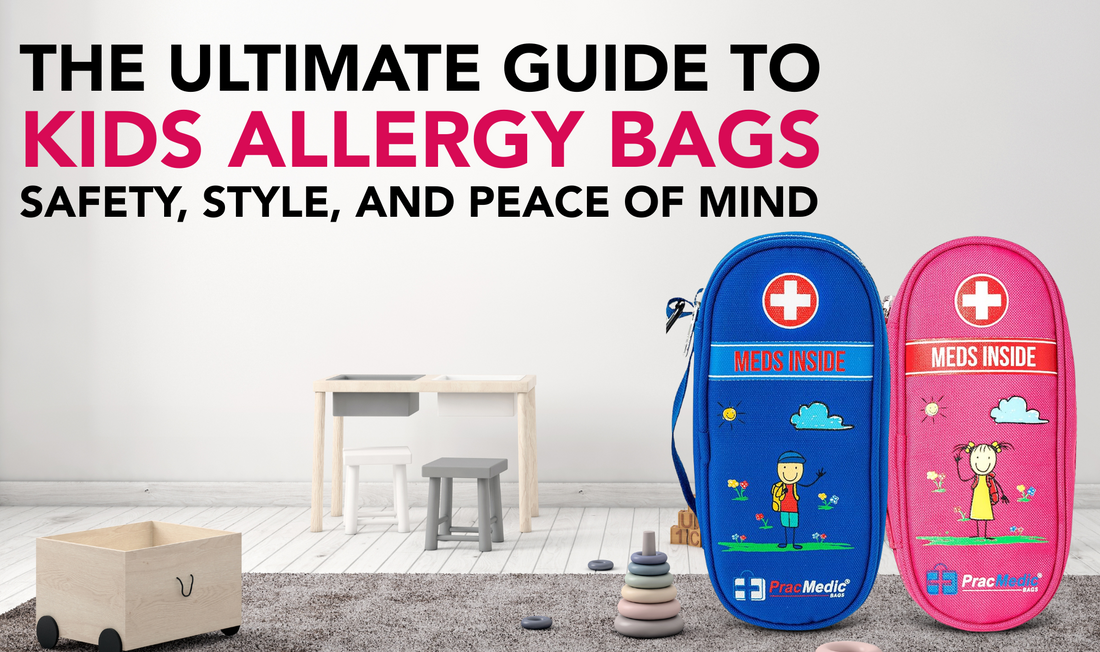
The Ultimate Guide to Kids Allergy Bags: Safety, Style, and Peace of Mind
Share
Parents of children with severe allergies know that preparedness is not just important—it’s essential. Allergies can be unpredictable and, in some cases, life-threatening. Having an emergency action plan in place and the right tools on hand can mean the difference between a manageable reaction and a medical emergency.
What is one of those crucial tools? A Kids Allergy Bag stocked with your medical essentials.
In this comprehensive guide, we'll explore why allergy bags are vital, especially for kids. We’ll also look at why more Australian parents are searching for high-quality Allergy Bags for their everyday use.
Why Every Child with Allergies Needs an Allergy Bag
Children spend time in school, at daycare, on playdates, and at extracurricular activities—sometimes without their parents nearby. A designated allergy bag ensures they have their medications readily available wherever they are.
1. Immediate Access to Life-Saving Medications
Allergy bags are specifically designed to carry epinephrine auto-injectors (like EpiPens), antihistamines, inhalers, and other essential medications. Having a child’s medicine properly stored and easy to access can be critical in a time-sensitive allergic reaction.
2. Helps Teachers and Caregivers Respond Effectively
Clearly labelled and well-organised allergy bags empower caregivers, teachers, and school nurses to act quickly during an emergency such as an allergic reaction.
3. Prevents Medication Loss or Damage
Unlike loose medication stored in backpacks or lunchboxes, a dedicated Allergy Medicine Case cushions sensitive medication from damage or exposure to extreme temperatures or being misplaced.
4. Promotes Independence and Confidence
With age-appropriate, child-friendly designs, kids feel more comfortable carrying their allergy bags, encouraging them to take responsibility for their health.
The Rise of Allergy Awareness in Australia
In recent years, awareness of food allergies and anaphylaxis has increased significantly in Australia. According to the ASCIA (Australasian Society of Clinical Immunology and Allergy), Australia has one of the highest allergy prevalence rates in the world. That’s why the demand for quality Allergy Bags Australia wide is growing rapidly.
School Allergy Policies
Australian schools are increasingly implementing anaphylaxis management policies, many of which require clearly labelled, personalised allergy bags for each child. This ensures teachers and staff can act promptly during emergencies.
Climate Considerations
Australia’s hot summers and cool winters create the need for insulated allergy cases that Insulates epinephrine and other medicines from extreme temperatures.
What to Look for in a Kids Allergy Bag?
When choosing the right allergy bag for your child, consider more than just the color or pattern. While aesthetics are great for getting kids excited, the primary function should always be safety, Insulation, and convenience.
1. Insulated Interior
Medications like EpiPens must be stored at controlled temperatures. An insulated interior helps cushion the epinephrine and maintain the medication’s effectiveness.
2. Clear Labelling
A visible medical alert symbol and customisable ID tag ensure anyone who sees the bag knows it contains life-saving allergy medication.
3. Durability
Kids can be rough on their belongings. Choose a bag that is sturdy, water-resistant, and able to withstand daily use.
4. Multiple Compartments
Allergy cases with separate pockets help organise different medications, action plans, and contact info, making it easier for caregivers to find what they need fast.
5. Kid-Friendly Design
Bags that feature fun prints, bright colors, or favourite characters encourage children to take ownership of their allergy management.
6. Portability
Lightweight and compact cases that can be clipped to backpacks, belt loops, or stored in lunchboxes are ideal for school and outings.
At PracMedic Bags, we design purpose-built allergy bags tailored to the needs of allergy or asthma families. Whether you're searching for a bright and bold case for a young child or a more discreet version for teens, we have options that combine safety with style.
Why Parents Love PracMedic Kids Allergy Bags:
- Insulated & weather-resistant to insulate medications
- Vibrant designs that kids enjoy carrying
- Clear medical labelling and ID card holders
- Space for multiple medications, including EpiPens, antihistamines, and inhalers
- Durable YKK zippers and compartments for organisation
- Travel-friendly design for travelling families
Explore our popular Sammie Medicine Case for Kids—a best-seller in the Allergy Bags Australia market. Its colourful look, child-safe materials, and functional layout make it the perfect go-to for school, sports, and travel.
Tips for Organising and Using Allergy Cases Effectively
Simply having an allergy bag isn’t enough. Knowing how to use it and keep it organised ensures it performs its job when needed.
1. Update Contents Regularly
Keep an eye on expiration dates. Replace medications as needed and review your child's allergy action plan yearly.
2. Include an Action Plan
Every allergy bag should include a printed copy of your child’s allergy action plan, signed by a doctor. This helps anyone caring for your child follow the right steps.
3. Use Labels
Label all medication with your child’s name and dosage instructions. This helps prevent confusion, especially in group settings.
4. Teach Your Child How to Use It
As kids grow, teach them how to recognise symptoms and how to use their auto-injector or inform an adult when symptoms occur.
5. Communicate with Teachers and Caregivers
Make sure everyone who spends time with your child knows about their allergies, where their bag is, and how to use its contents.
Take care and keep safe!
